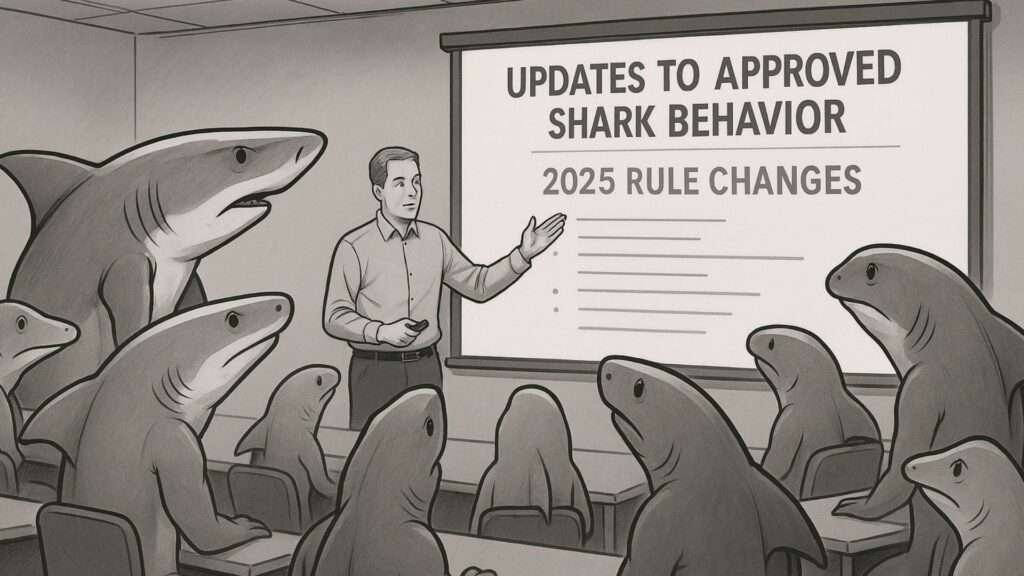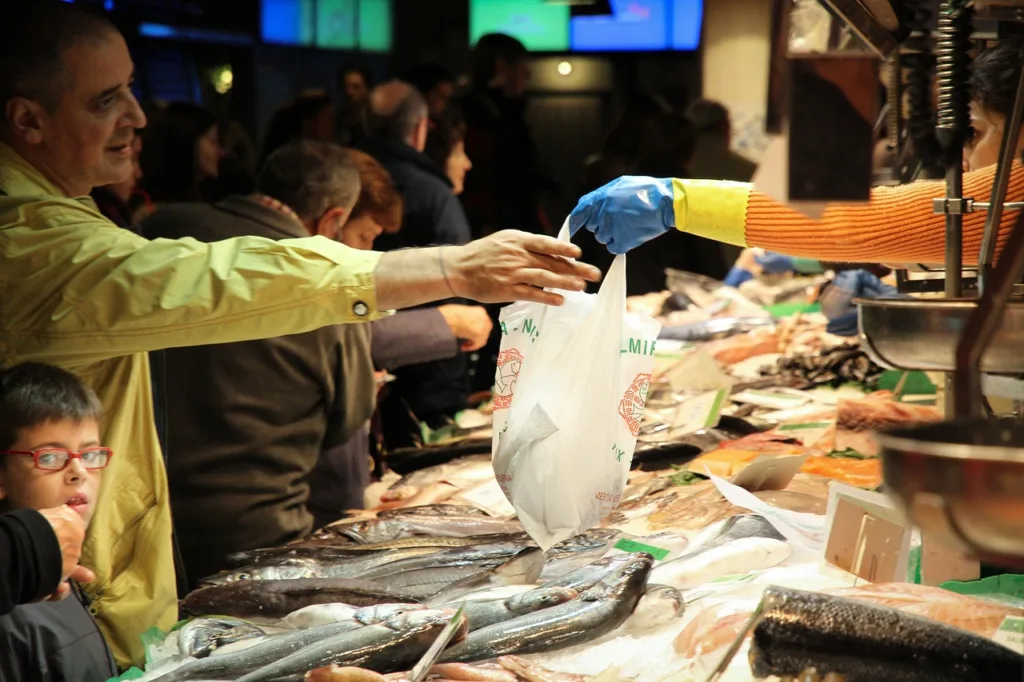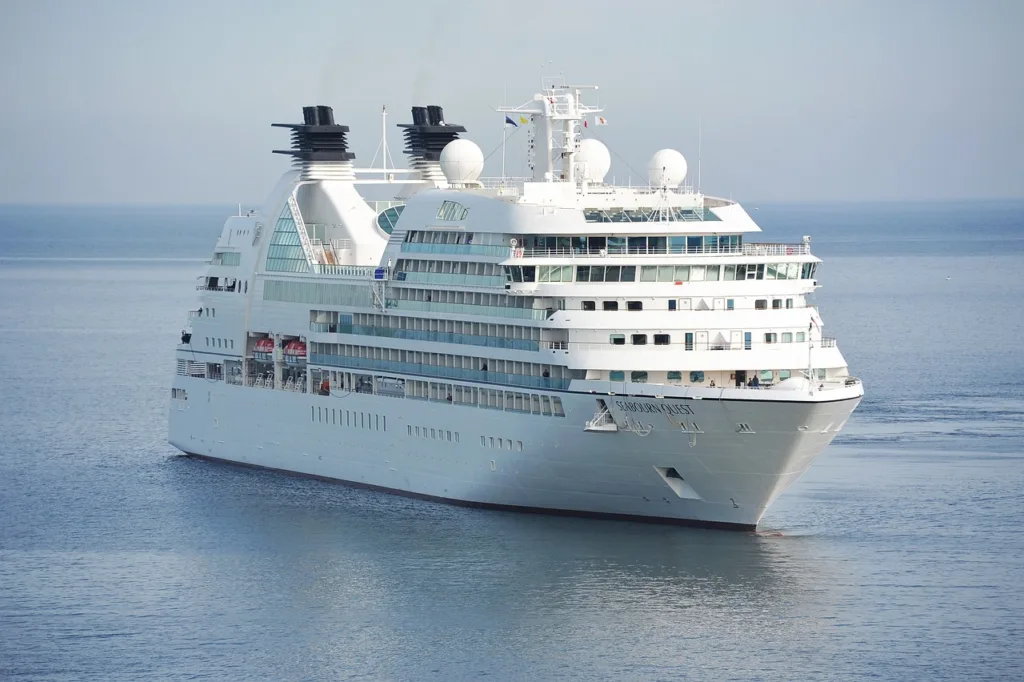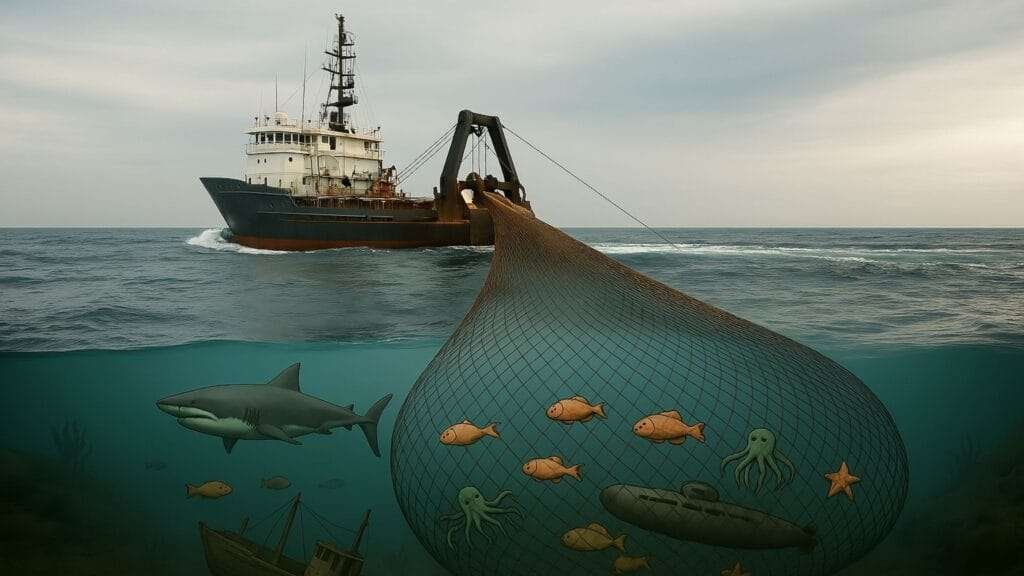
Artificial Shark Intelligence - Humanity's Ecological Blind Spot.
This article reframes shark–human conflicts as symptoms of our own environmental mismanagement rather than evidence of smarter sharks.
By treating sharks like software bugs, deploying drone patrols, apps, nets and culling programs, we ignore the true drivers of encounters:
1. Coastal population growth increases overlap with shark habitats.
2. Ocean warming alters migration patterns and extends shark residency.
3. Industrial fishing, especially supertrawlers, decimates prey stocks and disrupts food webs, pushing sharks shoreward.
4. Sensational media coverage warps statistical realities into public panic, skewing policy toward ineffective fixes.
I’ll argue that real progress hinges on ecosystem literacy and a shift from technological band-aids to root-cause interventions:
1. Reform fisheries: ban supertrawlers, outlaw destructive gear, set quotas by ecosystem capacity.
2. Expand Marine Protected Areas and restore critical habitats (mangroves, seagrasses).
3. Supplement with non-lethal safeguards: SMART drumlines, AI drones, personal electronic deterrents.
4. Develop inland aquatic venues (wave parks, lagoons) for shark-free recreation.
5. Cultivate cultural intelligence through community stewardship, policy innovation and education.
Ultimately, the only intelligence that needs an upgrade is ours, aligning human activity with natural systems rather than expecting sharks to adapt.
Table of Contents.
1.0 ASI – Artificial Shark Intelligence: What’s Going On?
1.1 Do Sharks Have Brains?
1.2 Shark Brain Size Relative to Their Body Mass.
1.3 Human Brain-to-Body Mass Ratio
1.4 The True “Superbrains” of the Animal Kingdom
1.5 Brain Implants and AI Integration: Humans Today, Sharks Tomorrow?
1.6 The Real ASI Crisis: We Made It Ourselves.
2.0 Shark Patrol: How Humans Outsource Safety to Technology.
3.0 The Tooth of the Matter: Why Sharks Are Showing Up More.
4.0 Super Trawlers Means Super Consequences.
5.0 Sharks Don’t Read Swim Safety Manuals & They Are Not Online.
6.0 Data vs. Drama: Media’s Role in Fear-Mongering
7.0 The Real Intelligence: Ecosystem Literacy.
8.0 Rethinking Shark Territory: Who Really Owns the Coastline?
9.0 Action Over Algorithms: Solutions That Actually Work.
10. Conclusion: The Only Creature That Needs To Change Is Us.
1.0 ASI – Artificial Shark Intelligence: What’s Going On?
In an era where artificial intelligence dominates headlines and promises to solve humanity’s greatest challenges, a different kind of intelligence has been quietly evolving beneath the waves.
Welcome to the age of Artificial Shark Intelligence (ASI), where apex predators seem to have developed an uncanny ability to appear exactly where humans least expect them, armed with what feels like an increasingly sophisticated understanding of our coastal routines.
1.1 Do Sharks Have Brains?
Yes they do. Sharks are cold-blooded vertebrates with a true brain protected by a cartilaginous skull. Their brain comprises forebrain, midbrain and hindbrain regions that process sensory inputs, control movement and regulate vital functions.
1.2 Shark Brain Size Relative to Their Body Mass.
Brain mass in sharks typically represents 0.2% to 0.5% of their total body weight, reflecting a compact yet highly efficient neural system suited for their predatory lifestyle.
Species | Average Brain Weight |
Great White Shark | ~500 g |
Hammerhead Shark | ~400 g |
Tiger Shark | 400–900 g |
Bull Shark | 140–500 g |
1.3 Human Brain-to-Body Mass Ratio
In contrast, humans have a brain that represents approximately 2–2.5% of our body mass. On average, an adult brain weighing 1.3–1.4 kg sits atop a ~60–70 kg body, giving a ratio near 1:40 (2.5%), often simplified to about 2% in popular sources.
1.4 The True “Superbrains” of the Animal Kingdom
We don’t hold the brain-mass ratio crown—ants do. Certain ant species pack an astonishing 12–15% of their body mass into their tiny brains.
- Brachymyrmex ants boast a ratio near 1:8 (≈12%)
- Some specialized ants reach up to 14–15%, the highest known for any animal
1.5 Brain Implants and AI Integration: Humans Today, Sharks Tomorrow?
Now, just in case you’re wondering whether sharks have suddenly grown hyper-intelligent or whether we’ve been inserting AI chips into their skulls—here’s where humanity actually stands with neural implants:
· Current State of Human BCIs • Coin-sized implants flush with the skull, ultrafine electrodes pick up motor-intent signals. • External AI decodes those signals to move cursors, control prosthetics, restore communication.
· The Next Frontier: On-Chip AI • Embedding tiny neural-network accelerators for real-time pattern recognition and adaptive feedback. • Potential uses: refining movement decoding, mood regulation, memory consolidation via targeted stimulation.
· Major Engineering Hurdles
1. Miniaturization: Squeezing processors, memory, power management into a biocompatible package.
2. Heat & Power: Active AI cores generate heat and demand energy—risks of tissue damage.
3. Longevity: Implants must resist biofouling and immune reactions for decades without replacement.
Even if we cracked all these challenges for humans, adapting the tech for sharks would be a whole new ocean of R&D. likely many decades away.
1.6 The Real ASI Crisis: We Made It Ourselves.
So no, sharks haven’t become super-intelligent overnight, and no, we haven’t turbocharged them with super-AI implants.
The “intelligence” we’re witnessing is entirely artificial in a different sense, it’s a manufactured crisis born from our ecological shortsightedness.
As shark sightings increase along Australian coastlines and public anxiety reaches fever pitch, we find ourselves attributing almost supernatural cunning to creatures simply responding to environmental chaos.
The real intelligence gap isn’t in the sharks, it’s in our understanding of the complex marine ecosystems we’ve been systematically dismantling.
While we’ve been busy developing apps to detect sharks and drones to monitor their movements, we’ve largely ignored the fundamental question: Why are they here in the first place?
This isn’t a story about sharks evolving superhuman brains to terrorize beachgoers. It’s about humans devolving in ecological awareness while expecting technology to paper over the cracks in our relationship with the ocean.
The sharks, it turns out, are just being sharks. The artificial part of this intelligence crisis is entirely our own creation.
2. Shark Patrol: How Humans Outsource Safety to Technology.
In our quest to reclaim the beaches from what we perceive as an increasingly intelligent shark menace, we’ve unleashed an arsenal of technological solutions that would make a Silicon Valley startup proud.
Drones patrol our coastlines like mechanical lifeguards, their cameras scanning for dorsal fins with the dedication of overachieving interns.
Smartphone apps ping notifications about nearby shark sightings faster than food delivery updates.
Sonar arrays sweep the waters with the thoroughness of airport security, while SMART drumlines promise “real-time shark management” as if we’re running an aquatic customer service department.
This technological shark patrol represents more than just our love affair with gadgetry, it reveals our fundamental belief that every natural problem has a digital solution.
We’ve created an elaborate theater of control, complete with emergency alert systems, acoustic receivers, and electric deterrent devices that promise to keep the ocean’s apex predators at bay through the power of innovation.
The irony, of course, is that these solutions treat sharks like a software bug that needs patching rather than addressing the underlying system failure.
We’ve essentially built a high-tech security system for a house we’re actively vandalizing. Traditional shark nets, despite being scientifically proven as “outdated technology” with 94% non-target species bycatch rates, persist because they create the illusion of action.
Meanwhile, our SMART drumlines tag and relocate sharks like we’re running a marine witness protection program, moving the problem rather than solving it.
This isn’t to dismiss all technological approaches, some, like non-lethal detection systems and personal deterrent devices, show genuine promise.
However, our collective faith in technological fixes reveals a deeper abdication of responsibility. We’d rather invest in shark-spotting drones than address the industrial fishing practices that have disrupted marine food chains.
We’d rather develop electric shark barriers than confront the climate change that’s altering ocean temperatures and species distributions.
The most sophisticated artificial intelligence in this scenario isn’t in our devices, it’s in our remarkable ability to engineer complex solutions while avoiding the simple truth that we’ve created this problem ourselves.
3. The Tooth of the Matter: Why Sharks Are Showing Up More.
The mystery of increasing shark encounters along Australian coastlines has less to do with sharks developing a taste for humans, it’s more to do with us fundamentally altering their world.
While public perception suggests an unprecedented boom in shark populations, scientific reality tells a different story, one of displacement, disruption, and climate-driven migration patterns that bring these apex predators into closer contact with our coastal communities.
The Australian Shark Attack File reveals a telling statistic: shark incidents have increased from an average of 6.5 per year in the 1990s to 15 per year in the subsequent decade.
But before we imagine sharks holding strategy meetings about beach invasion tactics, consider this: there’s “no evidence of increasing shark numbers that would influence the rise of attacks in Australian waters.
The mathematics are simple, the bigger the coastal populations, the more humans in the water and that equals more opportunities for encounters with these amazing apex predators.
However, the story becomes more complex when we examine the environmental forces reshaping shark behavior.
I know peoples eyes start to roll as soon as you mention ‘climate change’ but don’t stress, I’m not going to get carried away in that space.
However, Australia’s Eastern coastline has become a “climate change hotspot,” experiencing some of the world’s most rapid ocean warming.
This isn’t abstract environmental science, not some attempt to say something that will give the climate skeptics something to write about. There is change and it’s having measurable impacts on shark distribution patterns.
Sydney residents should note that recent studies show bull sharks are spending about 15 days longer per year off Sydney (compared to 15 years ago); their residency off Eastern Australia is indeed extending, increasing their overlap with people.
This extended residency directly increases their temporal overlap with people in estuarine and coastal areas.
Before I go any further, temporal overlap helps researchers understand how different species share time in the same habitat.
For example, if two predators hunt at night in the same area, they have high temporal overlap, which might lead to competition or avoidance behavior.
Continuing on, Eastern Australia coastline climate change is essentially rewriting the migration schedules that sharks have followed for millennia.
As water temperatures rise, species that once spent limited time in coastal areas are finding these waters increasingly hospitable for extended periods.
We’re witnessing a fundamental shift in marine biogeography, compressed into timeframes that human communities aren’t prepared to adapt to.
Meanwhile, the disruption of marine food chains through overfishing via monstrous supertrawlers creates additional pressures.
While the direct causal link between deep-ocean food scarcity and coastal shark migration isn’t as straightforward as often portrayed, the broader ecosystem disruption is undeniable.
When we extract 70% of oceanic shark populations through industrial fishing practices, we create a cascade of effects that ripple through entire marine ecosystems.
The real intelligence here isn’t artificial, it’s evolutionary. Sharks are demonstrating remarkable adaptability to rapidly changing ocean conditions, while humans struggle to comprehend the environmental systems we’ve spent decades destabilizing.
4.0 Super Trawlers Means Super Consequences.
Supertrawlers are the ocean’s industrial bulldozers, churning through ecosystems with factory-scale efficiency.
These vessels harvest fish by the hundreds of tonnes, leaving collapsed food webs in their wake. What experts call a “multi-faceted and considerable” threat to Australia’s marine heritage demands urgent scrutiny.
Case Study: The Geelong Star
· Vessel length: 95 m (small by supertrawler standards)
· Incident highlights: killed at least nine dolphins and four seals during a brief operation
· Legal fallout: exposed gaps in Australia’s conservation laws, branding enforcement “a farce”
This singular episode underscores how even sub-130 m ships inflict outsized ecological damage.
Mechanics of Destruction.
Supertrawlers decimate marine life through two main methods:
· Sweeping nets: Giant trawls up to 600 m long drag the seafloor like underwater bulldozers, stripping habitat and juvenile fish.
· Onboard processing: Fish are vacuumed, sorted, frozen and stored—all at sea for weeks—maximizing take before any chance of regulation or oversight.
The result is a rapid depletion of both target and non-target species, dismantling entire food webs.
Scale and Statistics – Top 10 Supertrawlers.
Name | Length | Gross Tonnage | Flag | Owner/Operator |
Annelies Ilena | 144.6 m | 14,055 t | Poland | Parlevliet & van der Plas |
Margiris | 142.7 m | 9,449 t | Lithuania | Parlevliet & van der Plas |
Willem van der Zwan | 142.3 m | 9,375 t | Netherlands | Willem van der Zwan en Zonen |
Maartje Theadora | 140.8 m | 9,082 t | Germany | Parlevliet & van der Plas |
Afrika | 126 m | 7,005 t | Netherlands | Cornelis Vrolijk Holding |
Carolien | 125 m | 6,910 t | Netherlands | Cornelis Vrolijk Holding |
Frank Bonefaas | 119 m | 6,512 t | UK | Cornelis Vrolijk Holding |
Arctica | 120.7 m | 7,765 t | Russia | Arkhangelsk Trawl Fleet |
Baltiyskaya Kosa | 120.4 m | 7,765 t | Russia | Kaichuang Deep Sea Fisheries |
Helen Mary | 116.7 m | 7,278 t | Germany | Parlevliet & van der Plas |
Key Metrics:
1. Catch capacity: up to 400 t in a single haul (Annelies Ilena).
2. Net span: as long as 600 m—enough to engulf 13 jumbo jets side by side.
3. Protected-area incursions: UK waters saw 2,963 hours of supertrawler fishing in 2019.
4. Storage: vessels like Viktor Gavrilov hold over 14,000 t of fish and stay at sea for 90 days.
5. Bycatch rates: non-target species (dolphins, seals, seabirds) can account for more than 25% of total haul.
6. Stock collapse: industrial fishing contributes up to 70% declines in some global fish populations.
Economic and Social Fallout.
Coastal communities bear the brunt of depleted stocks and ruined habitats:
· Local fishing businesses lose income as fish disappear.
· Tourism revenue declines when marine wildlife vanishes.
· Job losses in processing, retail and guiding services.
· Long-term food security threatened as reproductive capacity erodes.
These socio-economic shocks ripple far beyond harbour walls.
Regulatory Failures.
Current rules only restrict vessels over 130 m, yet smaller factory trawlers achieve the same destructive ends.
This is bureaucratic precision at the expense of ecological sense. A loophole that bans giant chainsaws while licensing industrial wood chippers, it calls for reforms such as:
1. Size-agnostic impact assessments.
2. Stricter bycatch limits and real-time monitoring.
3. No-go zones in critical habitats.
Without systemic change, supertrawlers will continue to outrun regulation.
Case Study: From Overfishing to Piracy off Somalia.
Once one of East Africa’s richest fishing grounds, Somali coastal waters were plundered after the central government sold off exclusive fishing rights to foreign fleets. Lacking any real oversight or enforcement, those fleets, many using industrial trawl gear akin to supertrawlers systematically stripped local stocks.
By the mid-2000s, subsistence fishers could not catch enough to feed their families or sell at market.
Facing destitution, coastal communities first set up makeshift “self-defence” patrols to keep illegal trawlers at bay.
Those patrols evolved into the piracy networks that grabbed global headlines: hijacking merchant vessels for ransom became a way to recoup losses from the collapse of the local marine economy.
In effect, oceanic industrial overfishing created both the motive and the means for modern Somali piracy.
3 Key points:
1. Government concessions to foreign fleets undermined traditional livelihoods.
2. Rapid stock depletion forced fishers ashore, with few alternative incomes.
3. “Coastguard” patrols morphed into ransom-driven piracy, exporting instability well beyond the Horn of Africa.
We Need Change And We Need It Today!
Supertrawlers epitomize short-term gain at the planet’s expense. Halting this industrial fishing juggernaut is essential to safeguard marine biodiversity, coastal economies and global food security. Engage by:
1. Supporting petitions for tougher trawler regulations.
2. Choosing certified sustainable seafood.
3. Spreading awareness through social media and local campaigns.
4. Stop eating fish/seafood, no demand for seafood means no more supertrawlers required.
Our oceans can’t afford another giant haul.
5. Sharks Don’t Read Swim Safety Manuals & They Are Not Online.
We’ve amassed an impressive arsenal of shark-safety tools, nets, culling programs, beach closures, decoys and acoustic deterrents, each premised on sharks abiding by our rules.
Yet these interventions share a fatal flaw: they assume apex predators will respect human boundaries, quotas, and warning signs.
Sharks respond to 400 million years of evolutionary cues, water temperature, prey patterns, breeding cycles and migratory rhythms that no net or policy can override.
Why Traditional Fixes Fall Short.
1. Shark nets Assumed benefit: Physical barrier stops sharks from reaching swimmers.
o Reality: Over one-third of sharks caught by nets are found on the beach side, implying they were already “protected” before entanglement.
2. Culling programs Assumed benefit: Fewer sharks equals fewer attacks.
o Reality: Research in Hawaii (2018) and New South Wales (2020) shows no clear link between local shark removals and incident rates.
3. Beach closures Assumed benefit: Remove humans until the water “resets.”
o Reality: Oceans are dynamic. No technology scans every cubic metre for sharks, temporary bans treat the symptom, not the underlying currents and animal behavior.
4. Decoys and acoustic deterrents Assumed benefit: Trick or scare sharks away with fake prey or sound pulses.
o Reality: Sharks detect electrical fields as faint as 0.5 billionths of a volt—roughly what a AA battery generates across 1,000 miles—making most deterrents negligible.
Intervention vs. Outcome.
Intervention | Claimed Benefit | Proven Outcome |
Nets | Physical barrier blocking sharks | ⅓ of netted sharks already inside “protected” zone |
Culling | Lower shark numbers reduce attack risk | Studies show no significant drop in incidents post-cull |
Beach Closures | Temporary human absence resets safety | Unable to monitor every metre; encounters resume on reopening |
Acoustic & Visual Decoys | Repel or distract with fake cues | Sharks’ electroreception makes these measures largely ineffective |
Shifting the Narrative.
Our true blind spot isn’t a lack of gadgets, it’s our stubborn belief in simple fixes for complex ecosystems.
By casting sharks as malicious beach terrorists, we dodge the harder work: restoring habitats, regulating fisheries and understanding how our activities reshape predator–prey dynamics.
Instead of teaching sharks to read a beach safety manual and getting them to sign and date is as documented proof that they have, we need to rewrite our own, grounding policies in ecology, not wishful thinking.
6. Data vs. Drama: Media’s Role in Fear-Mongering
Every summer, as reliably as beach umbrellas and sunscreen sales, arrives Australia’s annual shark panic season, a media phenomenon that transforms statistical anomalies into existential threats and isolated incidents into evidence of coordinated aquatic warfare.
The mechanics of this manufactured crisis deserve recognition as perhaps the most successful example of artificial intelligence in my entire shark narrative: the algorithmic precision with which fear generates clicks, views, and advertising revenue.
Consider the statistical reality:
Australia recorded nine unprovoked shark incidents in 2024, lower than the five-year average of 15 incidents, with zero fatalities across the entire continent.
The risk of a fatal shark attack averages 1.1 deaths per year nationally, you’re statistically more likely to be struck by lightning while winning the lottery.
Yet media coverage suggests an aquatic apocalypse where beaches have become feeding grounds for increasingly cunning predators.
This distortion operates through what researchers might call “availability bias amplification”, the human tendency to overestimate risks based on recent, vivid examples.
When a shark incident occurs, it triggers a cascade of related coverage: expert interviews, historical comparisons, safety segments, and inevitably, grainy underwater footage that transforms every shadow into a potential threat.
The media ecosystem feeds on itself, creating the illusion of escalating danger where none exists. The language of coverage reveals the narrative framework: sharks “attack” rather than “investigate,” they “hunt” rather than “forage,” and they demonstrate “cunning” rather than “instinctive behavior.”
This linguistic framing transforms normal predator-prey interactions into personal vendettas, anthropomorphizing creatures whose behavioral patterns have remained essentially unchanged for hundreds of millions of years.
Meanwhile, genuinely pressing marine issues, the collapse of fish stocks, climate-driven species migration, industrial fishing practices, receive a fraction of the coverage dedicated to shark encounters.
The annual destruction caused by supertrawlers doesn’t generate the same emotional response as a single bite incident, despite causing exponentially more ecological damage.
The most insidious aspect of this coverage is how it shapes public policy priorities. Politicians respond to perceived public concern rather than actual risk assessments, leading to resources being allocated to dramatic but ineffective measures like shark culling rather than addressing the underlying environmental factors driving increased encounters.
The artificial intelligence driving this media cycle isn’t technological, it’s economic. Algorithms optimize for engagement, not accuracy, creating feedback loops where sensationalism becomes indistinguishable from information.
7. The Real Intelligence: Ecosystem Literacy.
While we’ve been busy developing artificial solutions to our shark encounters, the real intelligence we need has been hiding in plain sight: the ability to read and understand the complex ecological systems that govern marine life.
This isn’t the kind of intelligence that can be coded into an app or embedded in a deterrent device, it’s the fundamental literacy required to comprehend how our actions ripple through interconnected biological networks.
Ecosystem literacy begins with recognizing that sharks aren’t isolated problems to be managed, but integral components of marine food webs whose health determines the stability of entire oceanic systems.
When we observe a bull shark lingering longer in temperate waters, we’re witnessing climate change in action.
When we see increased shark sightings near fishing areas, we’re observing the complex interplay between human activity and opportunistic feeding behavior.
These aren’t random events requiring technological solutions, they’re system responses that can be understood and anticipated through ecological knowledge.
The concept of “systemic intelligence” requires acknowledging human responsibility for environmental changes rather than treating natural responses as external problems.
Australia’s Marine Protected Areas provide compelling evidence of this approach: the Rowley Shoals and sections of the Great Barrier Reef demonstrate healthier shark populations specifically because human impacts have been managed and restricted. These areas function as living laboratories, showing what marine ecosystems can achieve when given space to recover.
This intelligence extends beyond scientific understanding to encompass what might be called “ecological empathy”, the ability to perceive environmental changes from the perspective of the species experiencing them.
When water temperatures rise by even a few degrees, it represents a fundamental shift in habitat suitability.
When industrial fishing removes massive quantities of prey species, it creates food web disruptions that cascade through multiple trophic levels.
Note: A trophic level is a group of organisms that share the same position in a food chain based on what they eat and what eats them.
True ecosystem literacy also involves understanding the temporal scales on which marine systems operate.
Sharks reach sexual maturity at 10-12 years, have pregnancies lasting 9-12 months, and produce relatively few offspring.
Their populations recover slowly from disruption, meaning that current encounters may reflect environmental changes that occurred years or decades ago. We’re often responding to symptoms of problems we created in the past while simultaneously creating new problems for the future.
The most sophisticated form of this intelligence involves recognizing that human and marine systems are fundamentally interconnected. Our coastal communities depend on healthy ocean ecosystems for tourism, fishing, and recreation.
Marine biodiversity supports the food webs that maintain fish stocks. Climate regulation by oceanic systems influences coastal weather patterns and sea levels. This systemic perspective reveals that “solving” the shark problem requires enhancing rather than degrading marine ecosystem health, the opposite of our current trajectory.
8. Rethinking Shark Territory: Who Really Owns the Coastline?
The question of coastal ownership reveals one of the most profound philosophical blind spots in our approach to shark encounters.
We’ve constructed elaborate legal and conceptual frameworks establishing human dominion over terrestrial landscapes, yet we venture into marine environments with the assumption that our terrestrial property rights somehow extend beneath the waves.
This presumption of oceanic ownership would be amusing if it weren’t driving policy decisions with serious ecological consequences.
From a shark’s perspective, if we can momentarily adopt such a viewpoint, the coastline represents seasonal hunting grounds, migration corridors and nursery areas that have been utilized for millions of years.
The relatively recent appearance of humans in these waters, particularly in the concentrations associated with modern beach culture, represents a novel environmental factor rather than a legitimate claim to territorial exclusivity.
We are, in essence, the new neighbors who moved into an established neighborhood and immediately began complaining about the existing residents.
This perspective shift becomes even more illuminating when we consider the temporal scales involved.
Modern beach recreation culture spans roughly a century, while shark utilization of these waters extends back hundreds of millions of years.
If we applied standard property law principles based on length of occupancy, sharks would hold undisputable title to virtually every coastal area on Earth.
Yet our response to encounters consistently assumes human priority: we deploy nets to exclude sharks from “our” beaches, relocate them from “our” swimming areas and develop deterrent technologies to make “our” recreational activities safer.
The language itself reveals the presumption, these are human spaces that sharks are intruding upon rather than shared marine environments where different species’ needs intersect.
The concept of humans as “coastal squatters” offers a useful reframing of the relationship. Like any squatters, we’ve established unauthorized residence in spaces we don’t legally own, then begun demanding that the original inhabitants accommodate our presence.
We’ve built infrastructure, established routines, and created communities based on the assumption of permanent occupancy rights that don’t actually exist in any meaningful ecological or legal framework.
This isn’t an argument for abandoning coastal recreation, but rather for recognizing that such activities occur as guests in marine ecosystems rather than as territorial rights-holders. Guest behavior implies different responsibilities: minimizing impact, respecting existing ecological relationships, and accepting that host preferences take precedence during conflicts.
Indigenous Australian perspectives offer valuable insights here, with traditional ownership concepts that recognize country as living systems rather than property to be exploited. These frameworks acknowledge human responsibilities to maintain ecological relationships rather than dominate them.
Perhaps the most intelligent approach to coastal coexistence involves abandoning the fiction of ownership in favor of developing sophisticated protocols for sharing space with other species.
This shift from dominion to diplomacy might actually prove more effective than our current approach of technological warfare against apex predators.
9. Action Over Algorithms: Solutions That Actually Work.

In the quest to resolve rising shark-human encounters, we’ve chased the allure of artificial intelligence, cutting-edge detection systems and algorithmic “fixes.”
Yet, time and evidence reveal a profound truth: what works isn’t futuristic tech, but our willingness to apply proven conservation principles that restore balance to our oceans.
Rather than manage the symptoms, with gadgets, panic and industrial-scale interventions, it’s time to confront the environmental root causes and embrace nature’s wisdom.
Challenging Technology-First Thinking.
Our culture’s infatuation with drones and AI-powered deterrents is understandable, but incomplete.
These tools often distract from underlying ecological damage and leave marine problems unresolved. Instead, addressing human actions that destabilize marine ecosystems is pivotal, a strategy grounded not in silicon and code, but in policy and collective will.
Root-Cause Solutions for Lasting Results.
Reforming Industrial Fishing.
1. Supertrawlers devastate marine food webs, depleting prey and driving sharks closer to shore. Comprehensive bans on these vessels and ecosystem-based fishing quotas are essential for system recovery.
2. Restricting destructive gear like bottom trawls and gillnets safeguards benthic habitats, preserving nursery grounds and maintaining healthy fish populations that keep sharks feeding safely offshore.
Expanding Marine Protected Areas (MPAs).
· No-take zones (e.g., the Rowley Shoals and parts of the Great Barrier Reef) sustain robust shark populations and prey stocks by limiting fishing pressure.
· Large, connected MPAs—ideally covering 30% or more of coastal waters—can triple prey biomass within a decade. Connectivity ensures sharks and prey can migrate and reproduce, stabilizing entire food webs.
Implementing Sustainable Fisheries Management.
1. Transitioning from maximum economic extraction to ecosystem-based quotas (capping at 80% reproductive capacity) prevents stock collapses.
2. Ensuring that commercial operations maintain healthy prey populations supports natural shark behavior, reducing risky coastward movements.
Restoring Key Habitats.
Programs to replant seagrass beds and mangroves rejuvenate crucial nursery habitats for juvenile fish, maintaining shark prey offshore and away from popular beaches.
Non-Lethal, Proactive Safety Nets.
While long-term change requires ecological action, immediate safety demands humane, science-based solutions.
· SMART Drumlines: Humane devices that intercept and relocate problematic sharks, offering real-time alerts and achieving ~95% average survival when moved offshore.
· AI-Enabled Drone Surveillance: Machine-learning models combined with drones identify sharks with up to 2m accuracy, relaying live data to lifeguards. In New South Wales, these patrols have slashed unplanned rescues by 65%.
· Wearable Electronic Deterrents: Personal field devices like Ocean Guardian have reduced close shark approaches by up to 80% in trials.
These strategies protect people without culling sharks or causing ecological damage, and are best viewed as supplements to—not substitutes for—comprehensive ecological management.
Engineered Aquatic Recreational Ecosystems.
For societies wanting both ocean thrills and zero shark risk, engineered alternatives are rising worldwide.
Facility Type | Example | Features | Benefits |
Wave Parks | Kelly Slater’s Surf Ranch (USA) | Programmable, world-class artificial waves | Shark-free, pro-level surfing |
Lagoon Swim Parks | Nusaaya Aquatic Resort (UAE) | Climate-controlled, lifeguard-monitored | Clean, safe water year-round |
Recreation Lakes | Blue Lagoon (Iceland) | Geothermally heated, mineral-rich | Kayaking, fishing, diving |
Advantages:
1. Eliminate shark encounter risk without coastal disruption.
2. Offer controlled, weather-proof recreation.
3. Reduce shoreline overcrowding and ecological stress.
4. Stimulate jobs in engineering, hospitality, and education.
5. Enable scalable water recreation in non-coastal regions.
Embedding Cultural Intelligence.
No technology can substitute for a society that prizes ecosystem health. Sustained change starts with cultural intelligence, recognizing our limits and responsibilities.
- Community Stewardship: Empowering Indigenous rangers and local communities integrates traditional knowledge with modern science for monitoring and protection.
- Policy Innovation: Encouraging eco-tourism and sustainable businesses to invest in MPAs creates incentives aligned with conservation and robust livelihoods.
- Education and Outreach: Embedding marine ecology and fisheries science in school curricula develops the next generation of ocean stewards.
The Ancient Wisdom of Working With, Not Against, Nature.
Healthy, functional ocean systems, featuring stable temperatures, diverse prey, and flourishing food webs act as natural buffers between sharks and people.
When these conditions prevail, sharks have little reason to approach busy shorelines.
The intelligence we need isn’t artificial: it is ancient, collective, and rooted in a history of respecting and restoring natural rhythms.
A Blueprint for Real Progress.
1. Restore and Connect MPAs: Scale up protected areas and join them into migration networks.
2. Reform Industrial Practices: Ban destructive trawling and cap catches at biologically meaningful limits.
3. Restore Habitats: Regenerate estuarine and benthic nurseries with mangrove and seagrass replanting.
4. Apply Immediate Safeguards: Deploy non-lethal, data-driven technologies wherever people swim.
5. Invest in Engineered Solutions: Build inland aquatic centers for safe, year-round recreation.
6. Prioritize Culture Over Code: Grow education, stewardship, and policy incentives for long-term ocean health.
By embracing these actionable, intelligent solutions, rooted in ecology rather than algorithms, we ensure safer oceans, thriving communities, and a sustainable blueprint for generations to come.
Don’t put off to tomorrow what you can do today, start the ball rolling and do what you can to help promote a better future for us all.
10. Conclusion: The Only Creature That Needs To Change Is Us.

As we reach the end of this deep dive into Artificial Shark Intelligence, the irony crystallizes: the only intelligence that needs upgrading is ours.
The sharks haven’t developed artificial intelligence, upgraded neural networks, or conspired to terrorize beachgoers. They are simply responding predictably to the environmental signals we’ve spent decades disrupting.
Every technological solution we deploy represents a theatrical attempt to manage symptoms while dodging the causes.
Drone surveillance and acoustic monitoring may look futuristic, but they’re reactive band-aids applied to deep ecological wounds.
The path forward doesn’t require AI, it requires courage:
1. The courage to ban destructive fishing practices.
2. The determination to make the change happen and to stop eating seafood.
3. The wisdom to expand MPAs.
4. The maturity to prioritize long-term ecosystem health over economic short-termism.
5. And yes, the creativity to build inland aquatic sanctuaries when true safety is the goal.
The climate pressures driving shark residency near our coastlines won’t reverse anytime soon. We face a choice: keep inventing artificial solutions to natural problems we’re causing or learn to live in alignment with the systems that sharks mastered long before we appeared.
If we’re smart, we’ll stop expecting sharks to change and if we truly don’t want to interact with them, we’ll stop entering their realm.
The oceans were never designed as theme parks but we can build theme parks anywhere. It’s time to stop swimming in denial and start engineering with wisdom.






